1.编写通常接受一个参数(字符串的地址),并打印该字符串的函数。然而,如果提供了第二个参数(int类型),且该参数不为0,则该函数打印字符串的次数将为该函数被调用的次数(注意,字符串的打印次数不等于第二个参数的值,而等于函数被调用的次数)。是的,这是一个非常可笑的函数,但它让读者能够使用本章介绍的一些技术。在一个简单的程序中使用该函数,以演示该函数是如何工作的。
1 #include <iostream>
2 using namespace std;
3
4 void print(char *str, int n = 0);
5
6 int main()
7 {
8 char *a = "I love China";
9 print(a);
10 print(a, 4);
11 print(a, 2);
12 print(a);
13
14 system("pause");
15 return 0;
16 }
17
18 void print(char *str, int n)
19 {
20 static int flag = 0; //通过static将flag设置为静态局部变量。如果将flag设置为全局变量,变量就不再属于函数本身,不再仅受函数的控制,给程序的维护带来不便。
21 flag++;
22 if (n == 0)
23 cout << str << endl;
24 else
25 {
26 for (int i = 0; i < flag; i++)
27 cout << str << endl;
28 }
29 cout << endl;
30 }
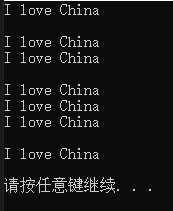
2、CandyBar结构饱含3个成员。第一个成员存储candy bar的品牌名称;第二个成员存储candy bar的重量(可能有小数);第三个成员存储candy bar的热量(整数)。请编写一个程序,它使用一个这样的函数,即将CandyBar的引用、char指针、double和int作为参数,并用最后3个值设置相应的结构成员。最后3个参数的默认值分别为"Millennium Munch"、2.85和350。另外,该程序还包含一个以CandyBar的引用为参数,并显示结构内容的函数。请尽可能使用const。
1 #include <iostream>
2 #include<string>
3 using namespace std;
4
5 struct CandyBar
6 {
7 //string brand;
8 char brand[40];
9 double weight;
10 int calorie;
11 };
12
13 void set(CandyBar &cb, char *b = "Millennium Munch", double w = 2.85, int c = 350);
14 void show(const CandyBar &cb);
15
16 int main()
17 {
18 CandyBar CBar;
19 set(CBar);
20 show(CBar);
21 set(CBar, "sa sa", 36.51, 660);
22 show(CBar);
23
24 system("pause");
25 return 0;
26 }
27
28 void set(CandyBar &cb, char *b , double w , int c )
29 {
30 //cb.brand = b; //如果brand是string,这里可以直接赋值
31 strcpy_s(cb.brand, b); //如果brand是char,字符串不能直接赋值,需要进行strcpy拷贝
32 cb.weight = w;
33 cb.calorie = c;
34 }
35
36 void show(const CandyBar &cb)
37 {
38 cout << cb.brand << endl;
39 cout << cb.weight << endl;
40 cout << cb.calorie << endl;
41 }
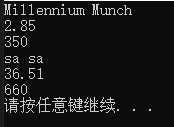
3、编写一个函数,它接受一个指向string对象的引用作为参数,并将该string对象的内容转换为大写,为此可使用表6.4描述的函数toupper()。.然后编写一个程序,它通过使用一个循环让你能够用不同的输入来测试这个函数,该程序运行情况如下:
Enter a string (q to quit) :go away
GO AWAY
Next string (q to quit) : good grief !
GOOD GRIEF!
Next string (q to quit) : q
Bye.
1 #include <iostream>
2 #include<string>
3 using namespace std;
4
5 void capital(string &s);
6
7 int main()
8 {
9 string str;
10 cout << "Enter a string (q to quit) :";
11 getline(cin, str);
12 while (str != "q")
13 {
14 capital(str);
15 cout << "Enter a string (q to quit) :";
16 getline(cin, str);
17
18 }
19 cout << "Bye." << endl;
20
21 system("pause");
22 return 0;
23 }
24
25 void capital(string &s)
26 {
27 for (int i = 0; i < s.size(); i++)
28 {
29 s[i]=toupper(s[i]);
30 cout << s[i];
31 }
32 cout << endl;
33 }
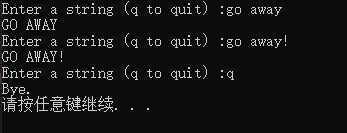
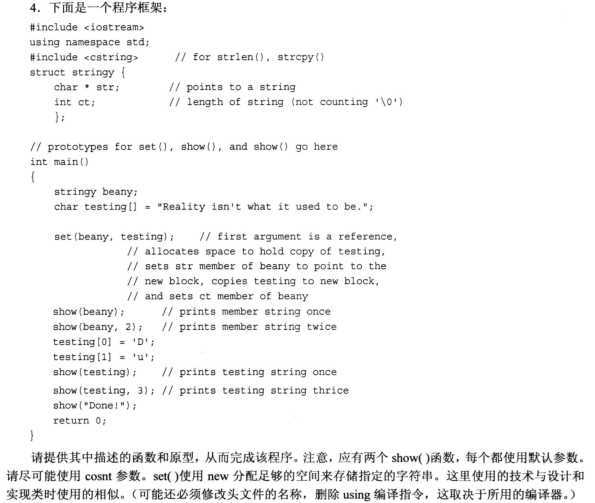
分析:
set()函数:使用new方法来分配内存空间给字符串,根据程序框架中的使用方式,该set()函数接受一个结构对象和一个char类型数组作为参数,然后使用new来给char类型数组分配长度,在这里为了获得char类型数组的长度以及将char类型数组的内容复制给其他变量,必须使用strcpy()函数和strlen()函数,这两个函数都是包含在头文件<cstring>中的。
1 #define _CRT_SECURE_NO_WARNINGS //vs2015会提示strcpy()函数不安全,必须改为使用strcpy_s()函数,这个语句可以关闭warning功能
2 #include <iostream>
3 #include<cstring>
4 using namespace std;
5
6 struct stringy
7 {
8 char *str;
9 int ct;
10 };
11
12 void set(stringy &s, const char *c);
13 void show(const stringy &s, const int n1 = 1);
14 void show(const char *c, const int n2 = 1);
15
16 int main()
17 {
18 stringy beany;
19 char testing[] = "Reality isn‘t what it used to be.";
20 set(beany, testing);
21 show(beany);
22 show(beany, 2);
23 testing[0] = ‘D‘;
24 testing[1] = ‘u‘;
25 show(testing);
26 show(testing, 3);
27 show("Done!");
28
29 system("pause");
30 return 0;
31 }
32
33 void set(stringy &s, const char *c)
34 {
35 int len = strlen(c);
36 s.ct = len;
37 s.str = new char[len + 1];
38 strcpy(s.str, c);
39
40 }
41
42 void show(const stringy &s, const int n1)
43 {
44 if (n1 < 0)
45 n1 = 0;
46 for (int i = 0; i < n1; i++)
47 cout << s.str << endl;
48 cout << endl;
49 }
50
51 void show(const char *c, const int n2)
52 {
53 if (n2 < 0)
54 n2 = 0;
55 for (int i = 0; i < n2; i++)
56 cout << c << endl;
57 cout << endl;
58 }

5、编写模板函数max5(),它将一个包含5个T类型元素的数组作为参数,并返回数组中最大的元素(由于长度固定,因此可以在循环中使用硬编码,而不必通过参数来传递)。在一个程序中使用该函数,将T替换为一个包含5个int值的数组和一个包含5个dowble值的数组,以测试该函数。
1 #include <iostream>
2 using namespace std;
3
4 const int n = 5;
5
6 template<typename T>
7 T max5(T arr[n]);
8
9 int main()
10 {
11 int a1 [5]= { 1,5,2,3,4 };
12 double a2[5] = { 2.5,3.7,8.9,1.4,2.33 };
13 cout << max5(a1) << endl;
14 cout << max5(a2) << endl;
15
16 system("pause");
17 return 0;
18 }
19
20 template<typename T>
21 T max5(T arr[n])
22 {
23 T max =arr[0];
24 for (int i = 0; i < n; i++)
25 {
26 if (arr[i] > max)
27 max = arr[i];
28 }
29 return max;
30 }

6、编写模板函数maxn(),它将由一个T类型元素组成的数组和一个表示数组元素数目的整数作为参数,并返回数组中最大的元素。在程序对它进行测试,该程序使用一个包含6个int元素的数组和一个包含4个double元素的数组来调用该函数。程序还包含一个具体化,它将char指针数组和数组中的指针数量作为参数,并返回最长的字符串的地址。如果有多个这样的字符串,则返回其中第一个字符串的地址。使用由5个字符串指针组成的数组来测试该具体化。
1 #include <iostream>
2 using namespace std;
3
4 template<typename T>
5 T maxn(T arr[], int n);
6 template<> char * maxn(char *arp[], int n); //或者template<> char * maxn <char *> (char *arp[], int n);
7
8 int main()
9 {
10 int a1[6] = { 1,5,2,3,4,10 };
11 double a2[4] = { 2.5,3.7,8.9,1.44 };
12 cout << maxn(a1, 6) << endl;
13 cout << maxn(a2, 4) << endl;
14 cout << endl;
15
16 char *arp[] = { "ald","sdaf","efrv","dsfrv","dfrvg" }; //指针数组
17 cout << maxn(arp, 5) << endl;
18
19 system("pause");
20 return 0;
21 }
22
23 template<typename T>
24 T maxn(T arr[], int n)
25 {
26 T max = arr[0];
27 for (int i = 0; i < n; i++)
28 {
29 if (arr[i] > max)
30 max = arr[i];
31 }
32 return max;
33 }
34
35 //模板具体化
36 template<> char * maxn(char *arp[], int n) //或者template<> char * maxn<char *>(char *arp[], int n)
37 {
38 int length = strlen(arp[0]);
39 char *p = arp[0];
40 for (int i = 0; i < n; i++)
41 {
42 if (strlen(arp[i]) > length)
43 {
44 length = strlen(arp[i]);
45 p = arp[i];
46 }
47
48 }
49 return p;
50 }
51
52 /*以下这种写法是错误的
53 template<> char * maxn(char *arp[], int n)
54 {
55 int length = strlen(arp[0]);
56 int i;
57 for (i = 0; i < n; i++)
58 {
59 if (strlen(arp[i]) > length)
60 length = strlen(arp[i]);
61 }
62 return arp[i];
63 }
64 */

7.修改程序清单8.14,使其使用两个名为SumArray()的模板函数来返回数组元素的总和,而不是显示数组的内容。程序应显示thing的总和以及所有debt的总和。
1 #include <iostream>
2 using namespace std;
3
4 template<typename T> //template A
5 T SumArray(T arr[], int n)
6 {
7 T sum = 0;
8 cout << "template A" << endl;
9 for (int i = 0; i < n; i++)
10 sum += arr[i];
11 return sum;
12 }
13
14 template<typename T> //template B
15 T SumArray(T *arr[], int n)
16 {
17 T sum = 0;
18 cout << "template B" << endl;
19 for (int i = 0; i < n; i++)
20 sum += *arr[i];
21 return sum;
22 }
23
24 struct debts
25 {
26 char name[50];
27 double amount;
28 };
29
30 int main()
31 {
32 int things[6] = { 13,31,103,301,310,130 };
33 struct debts mr_E[3] =
34 {
35 { "I W",2400.0 },
36 { "U F",1300.0 },
37 { "I S",1800.0 }
38 };
39 double *pd[3]; //指针数组
40 for (int i = 0; i < 3; i++)
41 {
42 pd[i] = &mr_E[i].amount;
43 }
44 cout << "sum of things:" << SumArray(things, 6) << endl;
45 cout << "sum of debts:" << SumArray(pd, 3) << endl;
46
47 system("pause");
48 return 0;
49 }
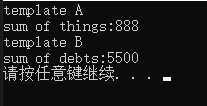
注:在此程序中,两个SumArray()模板函数的原型和定义分开会报错:

[C++ Primer Plus] 第8章、函数探幽——(二)课后习题
原文:https://www.cnblogs.com/Fionaaa/p/12639617.html